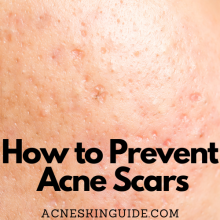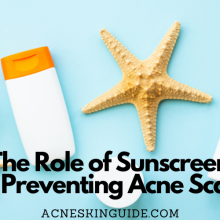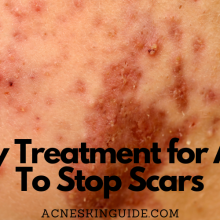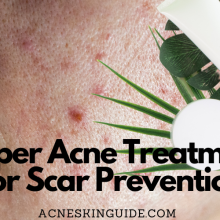Avoiding Acne Picking and Popping | Acne Skin Guide
Picking or popping pimples may seem tempting, but it disrupts the skin’s natural healing process and can lead to permanent acne scarring. When a pimple is picked, it allows air and bacteria into the area, causing further inflammation, destruction of healthy cells and collagen, and potentially resulting in indented atrophic scars, raised hypertrophic scars, or pigmentation issues.
Instead of picking, use safer acne treatments like spot treatments, warm compresses, pimple patches, or concealers. Breaking the ingrained habit requires identifying triggers, keeping hands busy, using pimple patches as barriers, and practicing behavioral techniques. For existing scars, treatment options range from over-the-counter scar gels to professional procedures like chemical peels, microneedling, laser resurfacing, fillers, or surgery. The key is diligently avoiding picking, allowing the skin to heal properly for clear, scar-free results.
#1 Recommended Acne Treatment | #2 Recommended Acne Treatment |
 |  |

The Perils of Picking: Why You Should Avoid Popping Pimples to Prevent Acne Scars
For anyone who has dealt with acne, the temptation to pick or pop a pimple is hard to resist. That raised, red bump seems to be begging to be drained. However, giving in to that urge can do much more harm than good, leading to further breakouts, increased inflammation, and permanent acne scarring. If you want to keep your skin clear and scar-free, it’s crucial to keep your hands off your face.
The Science Behind Acne Scarring
To understand why picking is so damaging, we need to look at what’s happening under the skin. Acne forms when excess oil, dead skin cells, and bacteria clog the pores. The body’s immune system then kicks in, causing redness and swelling – the visible pimple. If left alone, the pimple will eventually heal itself through this inflammatory response.
When you pick or pop, you are disrupting this natural healing cycle. By rupturing the pimple’s outer layers, you are providing an open pathway for air and more bacteria to enter the area. This extended inflammation leads to the destruction of healthy skin cells and collagen. As the area heals, the body produces too much or too little collagen, resulting in indented scars (atrophic) or raised scars (hypertrophic).
Types of Acne Scars
There are several types of acne scars that can occur from picking, each with their own appearance and challenges for treatment:
Ice pick scars: Deep, pitted scars that extend into the dermis
Boxcar scars: Broad depressions with sharply defined edges
Rolling scars: Broad depressions with sloping, irregular edges
Hypertrophic scars: Thick, raised scars caused by excessive collagen
Pigmentation issues: Areas of darker skin discoloration (hyperpigmentation)
Even if full scars don’t form, picking can lead to permanent reddish or purplish marks from burst blood vessels. These stubborn marks are known as post-inflammatory erythema or hyperpigmentation.
Safer Alternatives for Treating Pimples
Of course, the urge to pick is strong when a pimple forms. But there are much better, safer options that allow the skin to heal properly:
OTC Acne Spot Treatments: Look for products with benzoyl peroxide, salicylic acid or sulfur to help dry out blemishes.
Warm Compresses: Gently applying warmth can help bring a pimple to a head without aggressive popping.
Pimple Patches: Hydrocolloid patches protect the area and absorb fluid from whiteheads.
Hands-Off Concealing: Use a green-tinted color correcting concealer to camouflage pimples.
For serious inflammatory acne cysts, see a dermatologist for professional drainage or cortisone injections which reduces inflammation without rupturing the lesion.
Breaking the Picking Habit
Knowing the risks is one thing, but breaking an ingrained picking habit is difficult. It often stems from anxiety, stress, boredom or OCD tendencies. To stop picking:
Identify triggers: Are you picking more when stressed or looking in the mirror? Avoid those triggers.
Keep hands busy: Try squeezing a stress ball or fidgeting with another object to resist the urge.
Use pimple patches: The physical barrier prevents unconscious picking.
Get accountability: Have friends/family gently remind you when they catch you picking.
Try behavior techniques: Do habit-reversal training by squeezing fists when you get the urge.
See a therapist: For severe cases, getting counseling for anxiety/OCD can help break the cycle.
Treating Existing Acne Scars
If you are already dealing with acne scars from picking, there are professional treatment options ranging from over-the-counter to in-office procedures:
Scar Gels/Creams: Look for topicals with ingredients like vitamin C, retinol, alpha hydroxy acids to smooth texture.
Chemical Peels: These can improve coloring and mild surface scars.
Microneedling: This treatment uses tiny needles to stimulate collagen production.
Laser Resurfacing: Lasers remove the top layers of skin and trigger skin-tightening collagen.
Fillers: For depressed scars, dermal fillers can add volume and smoothness.
Surgical Revision: Dermabrasion or punch grafting may be used for severe ice pick scars.
The most important thing is to be diligent about stopping picking and adopting a consistent acne scar treatment plan under a dermatologist’s guidance.
While acne itself can be frustrating, repeatedly picking at pimples only leads to further breakouts and permanent scarring. There are always better solutions that allow the skin to heal itself properly. In the long run, keeping hands away from your face is the best way to get clear, scar-free skin.
Potential Downsides:
- It takes diligence and commitment to break an ingrained picking habit, which is difficult.
- Professional scar treatment options like lasers and surgery can be expensive.
- There is no overnight cure for acne scars – it is a process that takes months of treatment.
- Some may find concealing pimples challenging if they struggle with self-consciousness.
#1 Recommended Acne Treatment | #2 Recommended Acne Treatment |
 |  |
Summary and FAQs
Can toothpaste help dry out a pimple without popping it?
No, it is generally not recommended to use toothpaste to try to dry out a pimple. Here are a few reasons why toothpaste should be avoided for treating pimples:
- Toothpaste contains ingredients that can be very drying and irritating to the skin, such as hydrogen peroxide, baking soda, alcohol, menthol, and triclosan. These can actually cause more inflammation, redness, peeling, and potential scarring.
- The gritty texture of toothpaste creates physical abrasion and disruption of the skin’s surface when applied, which can worsen the pimple and spread bacteria.
- Toothpaste does not contain effective acne-fighting ingredients like salicylic acid or benzoyl peroxide found in over-the-counter acne treatments.
- Applying toothpaste to the face increases the risk of developing contact dermatitis or other allergic reactions in some people.
Instead of toothpaste, it’s better to use proper acne spot treatments formulated for the skin that contain ingredients like salicylic acid, benzoyl peroxide, or sulfur. These can help dry out pimples safely without popping or picking. Other gentle options are warm compresses or acne patches to help bring pimples to a head naturally. But toothpaste should be avoided as a DIY pimple remedy.
Is it okay to pop “whiteheads” or should I avoid popping any type of pimple?
It is best to avoid popping or picking at any type of pimple, including whiteheads. Here’s why:
While whiteheads may seem ready to be drained since they have a white/yellow center, popping them can actually slow down the healing process and lead to further inflammation, scarring, and even new breakouts.
When you pop a whitehead, you are creating an open wound on the skin. This allows air and bacteria to enter, increasing the risk of infection. It also damages the skin tissue and cells trying to heal the pimple naturally.
Picking or popping also drives the debris and bacteria further into the skin, rather than clearing it. This can cause the pimple to become more inflamed or lead to new pimples forming in that area.
Additionally, the squeezing and trauma from popping can cause hyperpigmentation (darkening of the skin) or even indented scars to develop once the area heals.
The safest approach is to avoid popping whiteheads and any other form of pimple. Instead, use a warm compress to help bring whiteheads to a head naturally. You can also try acne spot treatments with salicylic acid or benzoyl peroxide to help dry them out gently. Hydrocolloid pimple patches are another option to flatten whiteheads without picking.
With some patience, whiteheads will drain and heal on their own without the potential for scarring that comes from popping them. It’s best to keep hands off completely!
How can I cover up acne scars with makeup without making them worse?
Covering up acne scars with makeup requires some care to avoid worsening or irritating the scars. Here are some tips:
- Use non-comedogenic, oil-free makeup products. Look for labels that say “won’t clog pores” – these are less likely to cause new acne breakouts or exacerbate scarring.
- Properly cleanse and moisturize skin before applying makeup. This helps create a smooth canvas and prevents makeup from settling into scars.
- Use a green color-correcting primer or concealer first on red/pink scars. Green counteracts the redness.
- For indented/pitted scars, use a silicone-based pore-filling primer before foundation. This can temporarily “fill in” and smooth the texture.
- Opt for liquid or cream-based cosmetics like BB creams instead of powder foundations, which can settle into scars and accentuate them.
- Use a makeup sponge or damp beauty blender to gently pat and blend products over scars. Avoid vigorous rubbing.
- Set makeup with a finely-milled powder and setting spray to help it last without caking into scars.
- Avoid heavy, occlusive makeup that could further irritate scarred skin and clog pores. Let skin breathe.
- Remove all makeup gently before bed so scars can recover overnight. Use a fragrance-free makeup remover.
- Keep scars treated with acne medication in mind – let actives work uninterrupted at night without makeup.
With the right technique and non-comedogenic formulas, you can camouflage scarring while allowing it to heal. See a professional makeup artist for personalized scar coverage tips.
What role does diet play in acne scarring?
Diet alone does not directly cause or prevent acne scarring. However, certain dietary factors may influence acne severity, which can indirectly impact the risk of scarring from picking or popping pimples. Here’s how diet plays a role:
- High glycemic foods: Diets high in refined carbs, sugary foods/drinks can spike blood sugar and insulin levels. This may worsen acne by increasing oil production and inflammation. More inflamed pimples raise the likelihood of scarring if picked.
- Dairy products: There is some evidence that dairy, especially skim milk, may be linked to more acne breakouts for some people, potentially due to hormones and inflammatory proteins in milk.
- Fatty foods: Diets high in greasy fried foods and low in nutrients may promote acne by causing oxidative stress and inflammation in the body.
- Nutritional deficiencies: Not getting adequate nutrients like zinc, vitamin A, omega-3s may impact skin health and acne. Deficiencies could impair wound healing after pimple picking.
- Food sensitivities: For some, foods like gluten or specific food additives may trigger inflammation and acne flare-ups when consumed in excess.
While these factors may worsen acne severity, scarring itself is caused by picking/popping behaviors that damage the skin. Maintaining a balanced, anti-inflammatory diet can support clearer skin and faster healing to minimize future acne scars. But dietary changes alone can’t treat existing scars.
The best approach is not picking/popping pimples in the first place, while eating a nutrient-rich diet for overall skin health.
Can birth control help reduce acne scarring in women?
Birth control pills can potentially help reduce acne scarring in women, but indirectly rather than treating existing scars directly. Here’s how birth control may play a role:
- Regulates hormones
Many birth control pills contain synthetic versions of the hormones estrogen and progesterone. These hormones help regulate the natural hormonal fluctuations that can contribute to acne breakouts in women. - Reduces acne severity
By keeping hormones in balance, birth control pills can be effective at reducing the frequency and severity of acne breakouts in many women. Fewer large, inflamed pimples means less temptation to pick or pop them. - Prevents new pimples from forming
With consistent use, birth control can help stop new pimples from constantly forming and replacing old ones. This allows existing pimples to fully heal without the risk of re-injuring the skin. - Lowers inflammation
Some birth control formulations have anti-inflammatory effects that can directly reduce acne inflammation. Less swelling makes pimples look less tempting to try and “pop.”
However, birth control does not treat or improve the appearance of acne scars that have already formed from past picking behaviors. But by getting acne under better control, birth control gives the skin a chance to recover and reduces opportunities for new acne scars to develop.
It’s still important to avoid picking and let birth control do its work. For existing scars, separate professional treatments like laser resurfacing may be needed. But birth control can be a helpful option for some women to prevent future acne scarring.






